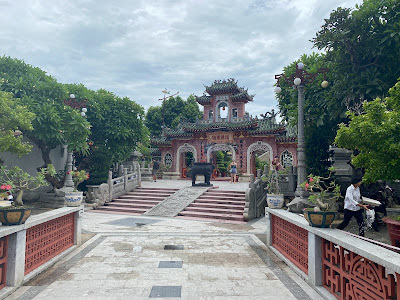
Our first stop in a whirlwind tour of southern Vietnam was Hoi An. It is a quaint, touristy area with seaside restaurants. There were numerous vintage houses with Chinese, Japanese, and Vietnamese architecture, but what used to be living space of families descended from merchants was stripped of its intimacy by big tourist groups.
 |
| I was bullied into taking this photo (famous covered bridge) |
 |
| Offerings at a temple |
 |
| Confucian Temple |
 |
| Confucian Temple |
 |
| Eating what felt like the Vietnamese equivalent of Taiwanese 熱炒 rechao |
Some gross miscalculations were made regarding our hostel on the island of Phu Quoc--including if anyone spoke English, when the power would be back on, and how we would pay. We left the non-air-conditioned Sleep Box to hunt down the fish sauce factory, but it was closed to visitors because of COVID. We still got to experience the fish sauce smells while walking lost through the fish market on the way.
 |
| Fish Sauce Factory |
 |
| Lighthouse temple |

 |
| Aquatopia, Vietnam |
The next day we took the longest over water cable car in the world to what we thought would be a beach. Instead, it was Asia's highest rated waterpark--lots of development of the area had happened in recent years. My dad and I went on every single water attraction, even though his inner ear otoliths were fully dislodged by the end. The scariest ride was a waterslide for which, after climbing up many stairs, we were weighed on a scale and put in a vertical tube with a glass door slid shut around us. After an electronic voice counted down in Vietnamese, the bottom dropped out of the tube.
 |
| Mala Bay, Taiwan |
It was a cultural experience going to a waterpark in Vietnam, especially because my first activity upon release from quarantine in Taiwan was a waterpark day in Taichung. The Vietnamese choice of attire when attending a waterpark is very different than in the US. Most people were wearing street clothes in the pools rather than bathing suits. Not a single bikini, but we did see some sweatshirts and jeans, despite the 90 degree weather. We even saw someone go down a waterslide in a mask. The attractions were familiar, but there were no lounge chairs. I got the sense that most of the people there did not know how to swim. Compared to Vietnam, the Taiwanese waterpark was much more similar to an American waterpark. Everyone was wearing bathing suits, although long-sleeve was the most common (for sun protection). As well, the Taiwanese waterpark required swim caps for all rides, and life jackets for most. At both Asian waterparks, there were extremely few apparent foreigners, maybe only a couple of foreign spouses at each. I have an untethered, yet strong memory of standing at the entrance to a wave pool in China about ten years ago. I was a skinny young teenager with extremely white skin wearing a bikini, and I remember feeling like that Chinese waterpark, while a mundane place for locals, was a deep cranny of China that saw very, very few foreigners.
 |
| 馬拉灣, Taiwan |
The entrance to the cable car was in an area called Sun Premier Villa Primavera. It is an entire resort town built over the past couple years to resemble old Europe, complete with the prefab ruins of a colosseum. The visitors' center reminded me of Caesar's Palace in Las Vegas, with faux columns and a painted on sky. Driving down the cobblestone streets was rather eerie, however. Every single brightly colored stucco building was still empty, with nothing but the remnants of construction materials to be seen behind the glass storefronts.



This dislodged a memory I had of a very similar resort that some friends took me to in China. It was the exact same style of modern architecture modeled on ancient Rome, and it had the exact same feel of Chinese investment spent constructing a place that now seemed abandoned by all but a few tour buses. Modern Asian luxury development will often use Western classical charm as their inspiration. I've been to many a private residential community in China with a vaguely Italian-sounding name, gilded gates, and marble sculptures. East Asian Studies scholars have written better pieces on how the values of creativity and imitation fit together in Chinese culture, but here's another extreme example of this concept:
https://www.nationalgeographic.com/travel/article/tianducheng-paris-of-the-east-replica.
 |
| Phu Quoc Night Market |
Our final South East Asia destination was Ho Chi Minh City. This was a tactile history lesson on the Vietnam War, and how history is written by the victors. There, the war is called the American War, or the Resistance War against the United States. At the Presidential Palace/Independence Palace, we saw the gates through which a North Vietnamese tank crashed, symbolizing the Fall of Saigon/Liberation of Saigon in 1975. We visited the War Remnants Museum, which powerfully documented war crimes during the Vietnam War/American War. We also visited the Cu Chi village tunnels, which was a less academic but very hands-on tour of guerrilla warfare. My mom managed to go twenty meters before her claustrophobia kicked in, all the while urging the Europeans in front of us to move faster.
 |
| Saigon Central Post Office |
 |
| Hum Vegetarian Restaurant |








































No comments:
Post a Comment